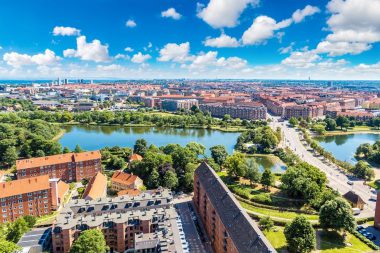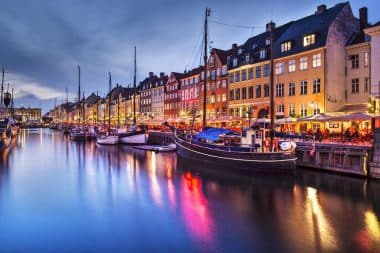The Danes have a reputation for being cozy. Her warm and cordial way of welcoming others comes in handy for travelers. If you want to experience peace and seclusion from everyday life, you should consider a holiday in Denmark. The country enchants young and old alike in its very own way. Delicious desserts, wild camping in permitted places and the beauty of the Wadden Sea are simply part of it.

Denmark is one of the Scandinavian countries and is located in the north of Europe. The largest peninsula of Jutland makes up the majority of the country. The rest consists of small islands, most of which are surrounded by the North Sea . Its only border leads directly to Germany. Danish is very similar to German, which is why you can read and understand Danish language very well. Many Danes also take the German language as a school subject and they can speak English very well.
Denmark is one of the twelve founding members of NATO and is affiliated with the EU. However, Denmark has its own currency, the Danish krone. One crown is worth about 0.13 euros. At the borders and in many banks in the country, crowns can be exchanged for euros. Some areas also accept euros, especially towards the German border. A credit card is always worthwhile, because the Danes are increasingly abolishing cash.

In the supermarkets you can find everything you need. However, the prices are significantly higher than in Germany. Spirits and tobacco products in particular are more expensive due to higher taxes. The cosiness of the Danes can be observed here again at the checkout. That’s why some time is required when shopping. This calm and serenity is contagious and has an effect on every stressed holidaymaker. After a stay in Denmark, you immediately feel more relaxed and relaxed.
This may also be due to the waves of the sea, which can be observed from the many coasts. The country is a real sailor’s and surfer’s paradise. Especially on the beach of Hvide Sande, water rats of all ages can pursue their interests. Whether windsurfing or kitesurfing, stand up paddling or water skiing: water sports enthusiasts get their money’s worth here. If you like to swim naked, Denmark is the place to be. This is allowed, unlike taking a sauna naked. To go to the sauna, bathing suits are absolutely necessary!
After a relaxing bath or sauna session, a rich meal is just the thing. The country’s culinary highlights include Rødgrød (red fruit jelly) or colourful fish platters. A classic Danish breakfast consists of wholemeal bread or Wienerbrød with jam or cheese, as well as healthy muesli. For dessert or afternoon tea, people like to eat Kanelsnegl (cinnamon rolls). Liquorice and smørrebrød are popular sweets and dishes of the Danes.
If you are interested in Danish culture and history, you should pay a visit to one of the numerous sights. In addition to the capital Copenhagen , Roskilde Cathedral is not only interesting for churchgoers. You can admire the crown jewels at Rosenborg Castle for a reasonable entrance fee, and the magnificent Frederiksborg Castle with its green park invites you to take a stroll. Denmark’s Wadden Sea is a UNESCO World Heritage Site and is real fun for young and old. Lugworms and seals can often be discovered on a guided tour through the Wadden Sea.
The most popular attractions in Denmark
Denmark, the land of Vikings and enchanting coastal landscapes, offers a variety of sights for travellers. Whether it’s historic castles, fascinating museums or impressive natural phenomena, Denmark has something for everyone. 1. Tivoli Gardens, Copenhagen
One of Denmark’s oldest and most famous attractions is the Tivoli Gardens in the capital city of Copenhagen. Opened in 1843, this theme park delights visitors with its beautiful gardens, rides, and cultural events. Especially at night, when the lights come on, a magical atmosphere is created. 2. Kronborg Castle, Helsingør
Kronborg Castle, also known as Elsinore from Shakespeare’s Hamlet, is one of the most important Renaissance castles in Northern Europe. It is located on the Öresund Strait and offers an impressive view of Sweden. The castle is a UNESCO World Heritage Site and a must-see for history buffs. 3. The Little Mermaid, Copenhagen
One of Denmark’s most recognizable landmarks is the statue of the Little Mermaid in Copenhagen. This bronze statue, based on Hans Christian Andersen’s fairy tale, attracts millions of visitors annually and is a symbol of Denmark’s connection to fairy tales and legends. 4. Wadden Sea
National Park For nature lovers, the Wadden Sea National Park on the Danish west coast offers a unique landscape. The Wadden Sea is part of the UNESCO World Heritage Site and is a paradise for birdwatchers and hikers. Here you can experience the phenomenon of the tides up close. 5. ARoS Aarhus Art Museum
The ARoS Art Museum in Aarhus is known for its modern art collection and impressive architecture. A highlight is the “Your Rainbow Panorama” walking tour, which offers a colorful view of the city.
Most popular cities in Denmark
Denmark is not only known for its breathtaking nature, but also for its charming cities. Each city has its own character, from the modern metropolis of Copenhagen to the quaint small towns. 1. Copenhagen
The Danish capital is the cultural and economic center of the country. Copenhagen offers a mix of historic buildings, modern architecture and green parks. Highlights include the Nyhavn Promenade, Tivoli Gardens, and Rundetårn. The city is also known for its bike-friendliness and sustainability. 2. Aarhus
Aarhus, Denmark’s second largest city, is located on the east coast of Jutland. It is a lively university city with a rich cultural offer. In addition to the ARoS Art Museum and the charming old town, the botanical garden is also worth a visit. Aarhus has a young and dynamic atmosphere and is particularly popular with young travellers. 3. Odense
Odense is best known as the birthplace of the famous fairy tale writer Hans Christian Andersen. Visitors can visit the Andersen Museum and the Andersen House to learn more about his life and works. Odense is located on the island of Funen and impresses with its quiet, historic charm. 4. Aalborg
Aalborg, in the north of Jutland, is a city that combines ancient history and modern development. The city is known for its Viking history, the Aalborg Historiske Museum and the House of Music. In recent years, Aalborg’s harbour district has developed into a modern meeting place with restaurants and art galleries. 5. Esbjerg
Esbjerg is the main port city on the west coast of Denmark and is known for its modern architecture. The “Man by the Sea” sculptures are one of the most striking landmarks of the city. Esbjerg is also the gateway to the island of Fanø, which is known for its pristine beaches and charming villages.
General information about Denmark
Denmark, the southernmost of the Scandinavian countries, is a popular destination for tourists from Germany and all over Europe. Here you can find out how to get from Germany to Denmark, what costs you can expect and which holidays you should be aware of. 1. Arrival from Germany
Denmark is easy to reach from Germany, both by car and by train, bus or plane.
By car, you can either cross the Flensburg border into Denmark or take the ferry from Puttgarden to Rødby. Both options are convenient and offer scenic routes.
If you travel by train, you can travel directly from Hamburg to Copenhagen – a journey that takes about 4.5 hours. Bus connections are also a cheap option. There are flights from many German airports to Copenhagen or Billund, with Billund being particularly interesting for families as it is close to Legoland. 2. Costs for supermarkets and living expenses
The cost of living in Denmark is slightly higher compared to Germany, especially when it comes to food. In supermarkets, you pay about 10-20% more for basic foodstuffs such as bread, milk and fruit than in Germany. The prices for alcohol and tobacco are particularly high, as they are heavily taxed.
Tip: Discounters such as Netto and Fakta offer cheaper alternatives, and in larger cities there are also markets where fresh, regional products are sold at moderate prices. 3. Holidays in Denmark
Denmark has several national holidays, some of which coincide with Germany. Among the most important are:
- New Year’s Day (1 January)
- Easter (Good Friday, Easter Sunday, Easter Monday)
- Labour Day (1 May, only partially)
- Ascension Day
- Whit Sunday and Whit Monday
- Christmas (25 and 26 December)
On these days, many shops are closed, and public transport runs less frequently. Especially at Christmas, the country is festively decorated, and there are traditional Christmas markets in many cities.
Travel information Denmark
| Capital | Copenhagen |
|---|---|
| Form of government | Parliamentary Hereditary Monarchy Parliamentary Democracy |
| Currency | Danish krone (DKK) |
| Area | Heartland 42,921 km²[1] Associated Greenland 2.2 million km² Associated Faroe Islands 1,396 km² |
| Population | Heartland approx. 5,748,700 (as of 2018)
Associated Greenland 56,584 |
| Languages | Danish |
| Electricity grid | 230 Volt / 50 Hz |
| Area code | Phone +45 |
| Time zone | UTC+1 CET UTC+2 CEST (March to October) |


